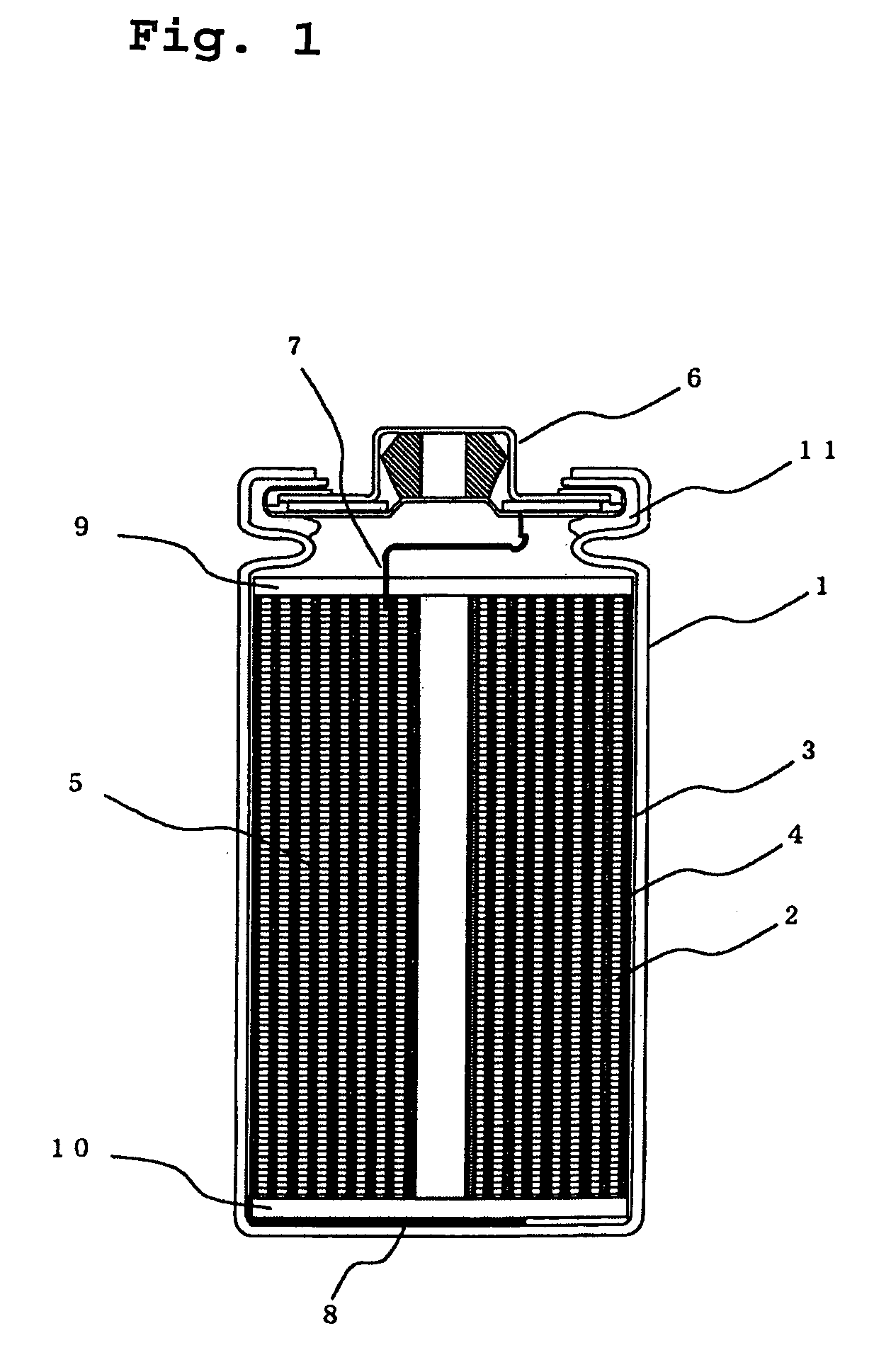Lithium secondary battery
a secondary battery and lithium battery technology, applied in the field of lithium secondary batteries, can solve the problems of deterioration of charge-discharge cycle performance, pulverizing of active materials into small particles or peeling from current collectors, and degradation of current collection performance within electrodes, so as to improve the charge-discharge cycle performance of lithium secondary batteries
- Summary
- Abstract
- Description
- Claims
- Application Information
AI Technical Summary
Benefits of technology
Problems solved by technology
Method used
Image
Examples
experiment 1
Preparation of Positive Electrode Active Material Al
[0088](1) Preparation of Lithium-Transition Metal Composite Oxide
[0089]Li2CO3 and CoCO3 were mixed in a mortar so that the mole ratio of Li and Co became 1:1. Thereafter, the mixture was sintered in an air atmosphere at 800° C. for 24 hours and then pulverized to obtain a powder of a lithium-cobalt composite oxide represented as LiCoO2 and having an average particle size of 11 μm.
[0090](2) Coating with Al2O3
[0091]A NH3 aqueous solution was dropped into 5 L of 0.1 M (mole / liter) Al(NO3)3 aqueous solution, and the resultant solution was agitated for 10 minutes, followed by centrifugal separation to remove the supernatant liquor. Thus, Al(OH)3 was obtained. This was added to 5 L of water and agitated for 10 minutes, to prepare a dispersion in which Al(OH)3 particles were dispersed. Then, 5,400 g of LiCoO2 was added to the dispersion, agitated for 10 minutes, and again subjected to centrifugal separation to remove the supernatant liqu...
experiment 2
[0100]Prismatic lithium secondary batteries were fabricated using the foregoing positive electrode active materials A1 through A6 and X1 in the following manner.
Preparation of Positive Electrode
[0101]A powder of each of the above-described positive electrode active materials, graphite powder having an average particle size of 2 μm as the positive electrode conductive agent, and polyvinylidene fluoride as the positive electrode binder were mixed so that the weight ratio of the active material, the conductive agent, and the binder became 95:2.5:2.5, and the mixture was kneaded to prepare a positive electrode mixture slurry.
[0102]The resultant positive electrode mixture slurry was applied onto both sides of a positive electrode current collector made of an aluminum foil with a thickness of 15 μm, a length of 402 mm, and a width of 50 mm so that the coating area on the obverse side had a length of 340 mm and a width of 50 mm and the coating area on the reverse side had a length of 270 m...
experiment 3
Preparation of Batteries A1-1 to A1-6 of the Invention
[0134]Using the positive electrode active material A1, Batteries A1-1 to A1-6 of the invention were fabricated in the same manner as Battery A1 of the invention, except that the positive electrode thicknesses were varied as shown in Table 3 by varying only the conditions of pressure-rolling when preparing the positive electrodes.
Preparation of Comparative Batteries X1-1 to X1-6
[0135]Using the comparative positive electrode active material X1, Comparative Batteries X1-1 to X1-6 were fabricated in the same manner as Comparative Battery X1, except that the positive electrode thicknesses were varied as shown in Table 3 by varying the conditions of pressure-rolling.
Evaluation of Charge-Discharge Cycle Performance and Battery Thickness after Initial Charge and Discharge
[0136]The charge-discharge cycle performance for each of Batteries A1-1 through A1-6 and Comparative Batteries X1-1 through X1-6 was evaluated in the same manner as des...
PUM
 Login to View More
Login to View More Abstract
Description
Claims
Application Information
 Login to View More
Login to View More - R&D
- Intellectual Property
- Life Sciences
- Materials
- Tech Scout
- Unparalleled Data Quality
- Higher Quality Content
- 60% Fewer Hallucinations
Browse by: Latest US Patents, China's latest patents, Technical Efficacy Thesaurus, Application Domain, Technology Topic, Popular Technical Reports.
© 2025 PatSnap. All rights reserved.Legal|Privacy policy|Modern Slavery Act Transparency Statement|Sitemap|About US| Contact US: help@patsnap.com



